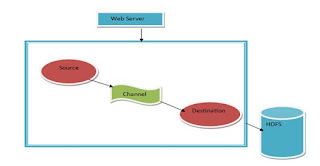You know that Apache sqoop which is a ingestion tool designed to
transfer data between RDBMS and Hadoop system.Let me discuss about Apache Flume.
Apache Flume is a data ingestion tool in Hadoop system and
has been developed by Cloudera to collect ,process, aggregating streaming data
from various servers and places in HDFS(Hadoop distributed file
system ) in a efficient and reliable manner.
Initially,
Apache Flume came into market to handle only log data of server. Later, it was equipped to
handle event data as well.
It is designed to perform high volume
ingestion of event based data into hadoop.
As of now we can assume one event
specifies one message which is going to be ingested in the hdfs. Once the data brings in hdfs, we
can perform own analysis on top of it.
Flume is easily integrated with other hadoop ecosystem
components including hbase and Solr.
Flume Architecture:
Let
me discuss about how flume works.
·
Event: A
single message transported by flume is
known as Event.
·
Client: It generates events and sends it to one or more
agents.
·
Agent: An
agent is responsible for receiving events from clients or other agents. Afterward, it
forwards it to its sink or agent. It is a
Java virtual machine in which Flume runs and configures and hosts the source, sink
and channel.
·
Source: Source receives
data from data generators as events and writes them on one or channels. It collects
the data from various sources, like
exec, avro, JMS, spool directory, etc.
·
Sink: It is
that component which consumes events from a channel and delivers data to the
destination or next hop. Also, we can say that the sink’s destination is might be
another agent or the central stores. There are multiple
sinks available that delivers data to a wide range of destinations. Example:
HDFS, HBase, logger etc.
·
Channel: It acts as a bridge between the sources and the sinks in Flume and
responsible for buffering the data. Events are
ingested by the sources into the channel and drained by the sinks from the
channel. There are multiple channels available like memory, JDBC etc.
Now we
will see how we can configure Flume Agent .

Each
flume source and sink type having different properties which need to
be declared in configuration file respectively .
The
command for execution of configuration file(.conf file) is:
flume-ng agent
-n <flume agent name declared in .conf file>
-c conf
-f < path of configuration file in hadoop system >
Now we will be configuring flume agent
where source is avro ,channel is memory and sink is hdfs.
# Declaring source,sinks and channel of Flume agent
Agent1.sources = avrosource
Agent1.sinks = hdfssink
Agent1.channels = Mchannel
#Defining source
Agent1.sources.avrosource.type
=avro
Agent1.sources.avrosource.bind =
<Ip
address of avro source>
Agent1.sources.avrosource.port =
<port
number of avro source>
#defining
sink
Agent1.sinks.hdfssink.type = hdfs
Agent1.sinks.hdfssink.hdfs.path =
<path name in hdfs to store file>
#defining
channel
Agent1.channels.Mchannel.type = memory
Agent1.channels.Mchannel.capacity = 10000
#Binding
channel between source and sink
Agent1.sources.avrosource.channels = Mchannel
Agent1.sinks.hdfssink.channel = Mchannel
This
is all about basic understanding of flume and now you get the idea
the how to configure flume agent and execute.
please
follow ItechShree
blog
for receiving more updates.Next will give you a example how to
configure flume
as spooling directory source.
See
you in my next blog!!







1 Comments
nicr information
ReplyDeletePlease do not enter any spam link in the comment box